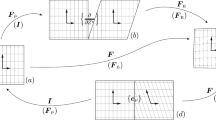Abstract
Recent advances in the continuum theory of dislocations have been achieved mainly in two directions: (1) the differential geometric (non-linear) theory of stationary dislocations, and (2) the formal linear dislocation dynamics. These two are unified here to form a differential geometric dynamical theory of continuous distributions of dislocations. To begin with, the basic concepts of the geometric theory are briefly summed up. The fundamental geometric equation of time-dependent distortions is derived first in a physically instructive elementary way and afterwards by means of exact differential geometry. A symmetrized form of the equation is given in terms of deformations or the metric tensor. The physical meaning of a previously introduced dislocation current tensor is discussed. A general form of the continuity equation for the dislocation current is then given. Thereafter the forces acting on dislocations are dealt with in connection with energy dissipation during plastic deformation and Ohm's law for dislocations, which has been introduced recently. The dislocation conductivity in simple cubic crystals is discussed. Finally, an invariant partition of the torsion (or dislocation) tensor is introduced. The semi-symmetrical part of this tensor corresponds to volume deformations, while the remainder is associated with shape deformations only. The main unsolved problems are enumerated, and some concluding remarks, concerned with the correspondence between dislocation theory on the one hand and general relativity and differential geometry on the other, are added.
Abstract
Последние успехи тео рии дислокаций относ ятся, главным образом, к дву м направлениям: (1) дифференциально-гео метрическая (нелиней ная) теория дислокаций и (2) формаль ная линейная динамика дислокаций. В настоящей работе об е теории объединяются в диффе ренциальногеометри ческую динамическую теорию непрерывного распре деления дислокаций. Сначала дан краткий обзор осн овных понятий геомет рической теории. Выводится фун даментальное геометрическое урав нение временно перем енных дисторсий в первую оч ередь физически наглядным элементар ным способом, а затем с трогими методами дифференци альной геометрии. Дается симметричная форма этого уравнени я, выраженная с помощью деформаций или метрического тен зора. Обсуждается физ ический смысл раньше введенн ого тензора тока дислокаций. Приводит ся общая форма уравне ния непрерывности тока д ислокаций. Потом обсуждены силы, дейст вующие на дислокации, и связи с рассеянием энергии в течение пластическо й деформациии и с недав но введенным законом Ома теории дислокаций. Обсуждае тся дислокационная пров одимость простых куб ических кристаллов. В конце вв одится инвариантное разделение тензора к ручения (или дислокац ий). Полусимметричная ча сть тензора соответствует объем ной деформации, в то вр емя как остальная его часть о тносится только к деформации сдвига. П еречислены важнейши е неразрешенные пробл емы и добавлено неско лько заключительных заме чаний о связи между те орией дислокаций, с одной ст ороны, и общей теорией относ ительности и диффере нциальной геометрией, с другой с тороны.
Similar content being viewed by others
References
Holländer E. F.: Czech. J. Phys.B 10 (1960), 409.
Holländer E. F.: Czech. J. Phys.B 10 (1960), 479.
Holländer E. F.: Czech. J. Phys.B 10 (1960), 551.
Bilby B. A.: Bristol Conference Report on Defects in Crystalline Solids, The Physical Society, London 1955, p. 124.
Bilby B. A., Bullough R., Smith E.: Proc. Roy. Soc.A 231 (1955), 263.
Bilby B. A., Smith E.: Proc. Roy. Soc.A 236 (1956), 481.
Bilby B. A., Bullough R., Gardner L. R. T., Smith E.: Proc. Roy. Soc.A 244 (1958), 538.
Bilby B. A., Gardner L. R. T.: Proc. Roy. Soc.A 247 (1958), 92.
Kondo K.: On the Geometrical and Physical Foundations of the Theory of Yielding, Proc. 2. Japan. Nat. Congress of Appl. Mech., Tokyo 1952, p. 41.
Kondo K.: Memoirs of the Unifying Study of the Basic Problems in Engineering by Means of Geometry I., II., Gakujutsu Bunken Fukyu-Kai, Tokyo 1955, 1958.
Kröner E.: Kontinuumstheorie der Versetzungen und Eigenspannungen, Springer, Berlin-Göttingen-Heidelberg 1958.
Kröner E.: Arch. Rat. Mech. Anal.4 (1960), 273.
Kröner E., Seeger A.: Arch. Rat. Mech. Anal.3 (1959), 97.
Schouten J. A.: Ricci-Calculus, 2nd ed., Springer, Berlin-Göttingen-Heidelberg 1954.
Рашевский П. К.: Рима нова геометрия и тенз орный анализ, ГИТТЛ, М осква 1953.
Peach M., Koehler J. S.: Phys. Rev.80 (1950), 436.
Johnston W. G., Gilman J. J.: J. Appl. Phys.30, (1959), 129.
Author information
Authors and Affiliations
Rights and permissions
About this article
Cite this article
Holländer, E.F. The geometric equation of dislocation dynamics. Czech J Phys 12, 35–47 (1962). https://doi.org/10.1007/BF01688395
Received:
Issue Date:
DOI: https://doi.org/10.1007/BF01688395




